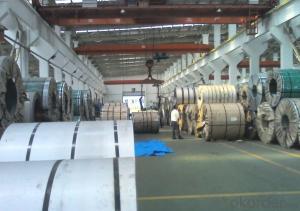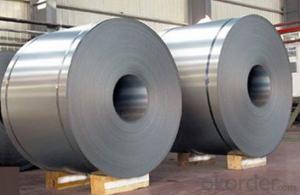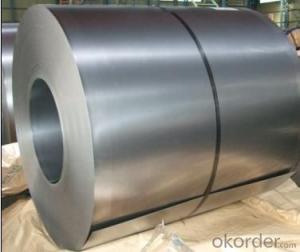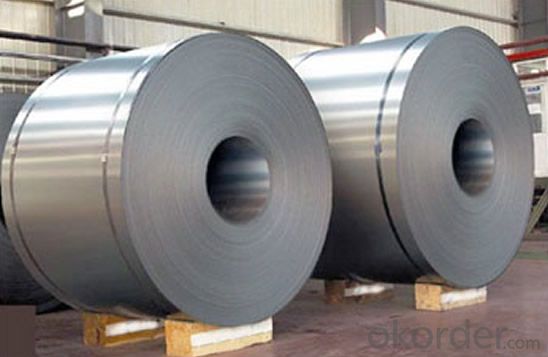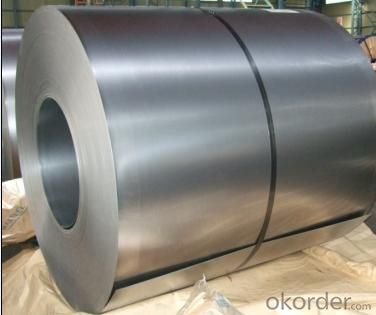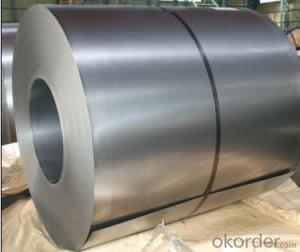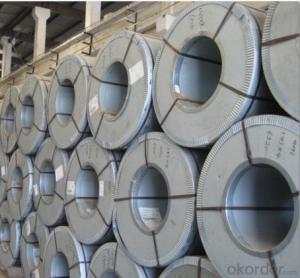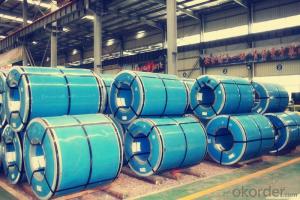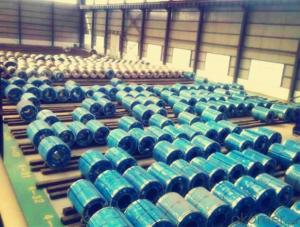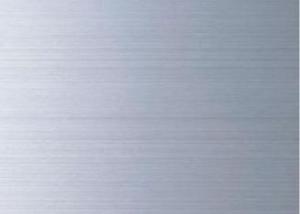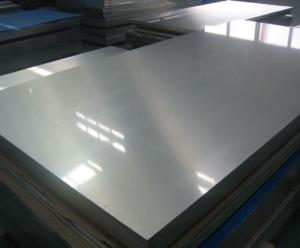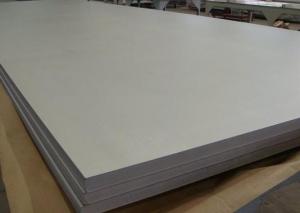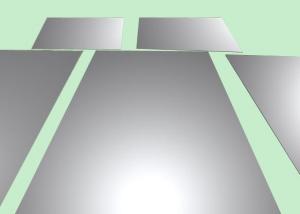Stainless Steel Coil/Sheet/Strip 304 Hot/Cold Rolled 2B/BA/NO.1
- Loading Port:
- Guangzhou
- Payment Terms:
- TT OR LC
- Min Order Qty:
- 100 m.t.
- Supply Capability:
- 20000 m.t./month
OKorder Service Pledge
OKorder Financial Service
You Might Also Like
Hot Rolled Stainless Steel Coil 304
Stainless steel is a production which not easy rust,acid resistance and corrosion resistance,so it is widely
used in light industry,heavy industry,daily necessities and the decoration industry.
Hot Rolled Stainless Steel Coil 304 Specifications
1.surface:NO.1
2.standard:JIS, AISI, GB
3.width: 0.55m, 0.65m, 1.0m, 1.22m, 1.5m, 2m or requirement
Hot Rolled Stainless Steel Coil 304 Chemical Composition:
(%):C=0.07, Mn=2.00, P=0.045, S=0.030, Si=0.075, Cr=17.5-19.5, Ni=8.0-10.5, N=0.10
Hot Rolled Stainless Steel Coil 304 Physical Properties
Tensile strength σb (MPa) ≥ 520
the conditions yield strength σ0.2 (MPa) ≥ 205,
elongation δ5 (%) ≥ 40
Reduction of ψ (%) ≥ 50,
hardness: ≤ 187
HB; ≤ 90
HRB; ≤ 200H
- Q: How do you prevent corrosion fatigue of stainless steel strips?
- To prevent corrosion fatigue of stainless steel strips, there are several measures that can be taken: 1. Proper material selection: Choose a stainless steel grade that is resistant to corrosion and fatigue. Grades such as 316 and 304L are commonly used for their excellent corrosion resistance properties. 2. Surface treatment: Apply a protective coating or passivation treatment to the stainless steel strips. This will enhance the corrosion resistance and prevent the initiation of fatigue cracks. 3. Regular cleaning and maintenance: Keep the stainless steel strips clean and free from contaminants that can accelerate corrosion. Regularly inspect the strips for any signs of corrosion or fatigue and address them promptly. 4. Avoid harsh environments: Limit exposure of the stainless steel strips to corrosive environments such as saltwater, acidic solutions, or high humidity conditions. If exposure is necessary, consider implementing additional protective measures like applying a barrier coating or using cathodic protection. 5. Proper handling and storage: Handle the stainless steel strips with care to prevent any damage that could lead to corrosion or fatigue cracks. Store them in a dry and controlled environment to avoid exposure to moisture or other corrosive agents. 6. Design considerations: Ensure that the design of the stainless steel strips takes into account factors such as stress concentration, surface finish, and proper installation techniques. These considerations can help minimize the risk of fatigue and corrosion. 7. Regular inspections and testing: Implement a regular inspection and testing program to detect any early signs of corrosion fatigue. This can include visual inspections, non-destructive testing methods, and monitoring of environmental conditions. By implementing these preventive measures, the risk of corrosion fatigue in stainless steel strips can be significantly reduced, ensuring their long-term durability and performance.
- Q: Can stainless steel strips be used in the wastewater treatment industry?
- Yes, stainless steel strips can be used in the wastewater treatment industry. Stainless steel is highly resistant to corrosion and can withstand exposure to chemicals and harsh environments, making it an ideal material for various components in wastewater treatment systems. It is commonly used for constructing tanks, pipes, valves, screens, and other equipment that come into contact with wastewater. The durability and longevity of stainless steel strips make them a cost-effective and reliable choice for the wastewater treatment industry.
- Q: Can stainless steel strips be used in the production of kitchen sinks?
- Yes, stainless steel strips can be used in the production of kitchen sinks. Stainless steel is a popular material choice for kitchen sinks due to its durability, corrosion resistance, and ability to maintain a clean and hygienic surface. Stainless steel strips can be shaped and welded to create the various components of a kitchen sink, such as the basin and drainboard. The strips can also be polished to achieve a smooth and sleek finish. Additionally, stainless steel strips offer ease of maintenance and long-lasting performance, making them a suitable choice for kitchen sink production.
- Q: What are the common tests performed on stainless steel strips?
- There are several common tests performed on stainless steel strips to ensure their quality and suitability for various applications. Some of these tests include: 1. Chemical Composition Analysis: This test determines the elemental composition of the stainless steel strip, including the percentage of various alloying elements such as chromium, nickel, and molybdenum. It helps verify if the material meets the required specifications and standards. 2. Mechanical Properties Testing: This involves evaluating the mechanical characteristics of the stainless steel strip, including its tensile strength, yield strength, elongation, and hardness. These properties are crucial in determining the material's strength and durability. 3. Corrosion Resistance Testing: Stainless steel is known for its excellent corrosion resistance. Tests such as salt spray testing, pitting corrosion testing, and intergranular corrosion testing assess the strip's resistance against various corrosive environments. These tests ensure that the stainless steel strip will perform well in its intended application. 4. Surface Finish Analysis: This test examines the surface quality of the stainless steel strip, including the presence of any defects, scratches, or blemishes. It ensures that the surface finish meets the required standards and provides the desired aesthetic appearance. 5. Dimensional Inspection: This test verifies the dimensional accuracy and tolerances of the stainless steel strip. It ensures that the strip's width, thickness, and length meet the specified requirements. 6. Microstructure Examination: This test involves analyzing the microstructure of the stainless steel strip using techniques like metallography and microscopy. It helps identify any potential defects or abnormalities that may affect the material's performance. These tests are essential in ensuring the quality, reliability, and performance of stainless steel strips in various industries, including automotive, construction, and manufacturing. By conducting these tests, manufacturers can deliver stainless steel strips that meet the highest standards and customer expectations.
- Q: What is the impact toughness after cryogenic treatment of stainless steel strips?
- The impact toughness of stainless steel strips is generally improved after cryogenic treatment. Cryogenic treatment involves subjecting the steel to extremely low temperatures, typically around -196°C (-321°F), to enhance its mechanical properties. This process causes a transformation of the steel's microstructure, resulting in increased hardness, strength, and resistance to wear. The impact toughness of a material refers to its ability to absorb energy and resist fracture under high-stress conditions. Cryogenic treatment helps to refine the microstructure of stainless steel, reducing the presence of brittle phases and improving its resistance to cracking or fracture when subjected to impact or high-stress situations. The low-temperature treatment also reduces residual stresses in the steel, which can further enhance its impact toughness. The reduction in residual stresses helps to improve the steel's ductility, making it less prone to sudden failure or fracture under impact or high-stress loads. Overall, the cryogenic treatment of stainless steel strips enhances their impact toughness, making them more suitable for applications that require high durability, resistance to cracking, and improved performance under impact or high-stress conditions.
- Q: How do stainless steel strips compare to other types of steel?
- Stainless steel strips have several advantages over other types of steel. Firstly, stainless steel is highly resistant to corrosion and rust due to the presence of chromium. This makes it ideal for applications where the steel will be exposed to moisture or harsh environments. In contrast, other types of steel may require additional coatings or treatments to achieve similar levels of corrosion resistance. Additionally, stainless steel strips have excellent strength and durability properties, making them suitable for a wide range of applications. They have a high tensile strength, which means they can withstand heavy loads without deforming or breaking. This makes stainless steel strips a popular choice for structural components in industries such as construction, automotive, and aerospace. Furthermore, stainless steel is known for its aesthetic appeal. It has a clean, shiny appearance that can be maintained even in harsh conditions. This makes stainless steel strips a preferred choice for applications where visual appeal is important, such as architectural and decorative purposes. Another advantage of stainless steel strips is their low maintenance requirements. They are relatively easy to clean and do not require regular painting or coating to maintain their appearance and durability. This can result in cost savings and reduced maintenance efforts compared to other types of steel. However, it is important to note that stainless steel strips may be more expensive initially compared to other types of steel. This is due to the higher production costs associated with the alloying elements, particularly chromium, which gives stainless steel its unique properties. Nonetheless, the long-term benefits and durability of stainless steel strips often outweigh the initial cost difference. Overall, stainless steel strips offer superior corrosion resistance, strength, durability, aesthetic appeal, and low maintenance requirements compared to other types of steel. These advantages make them a popular choice in various industries and applications.
- Q: What are the common industry standards for stainless steel strips?
- The common industry standards for stainless steel strips include ASTM A240, ASTM A666, EN 10088-2, and JIS G4305. These standards specify the composition, mechanical properties, dimensions, and tolerances for stainless steel strips, ensuring consistency and quality across the industry.
- Q: Can stainless steel strips be used for architectural balustrades?
- Yes, stainless steel strips can be used for architectural balustrades. Stainless steel is a popular material choice for balustrades in architectural applications due to its durability, strength, and aesthetic appeal. Stainless steel strips can be shaped, bent, and welded to create intricate and stylish balustrade designs. Additionally, stainless steel is resistant to corrosion, making it suitable for both indoor and outdoor use. The smooth and polished surface of stainless steel strips adds a modern and sleek look to architectural balustrades, making them a popular choice in contemporary designs.
- Q: Are stainless steel strips resistant to phosphoric acid?
- Yes, stainless steel strips are generally resistant to phosphoric acid. Stainless steel is known for its corrosion resistance due to the presence of chromium and other alloying elements. Phosphoric acid is a relatively mild acid and does not typically cause significant corrosion or damage to stainless steel. However, it is important to note that prolonged exposure to high concentrations or elevated temperatures of phosphoric acid may still cause some corrosion or pitting on the surface of stainless steel. Therefore, it is recommended to avoid prolonged or excessive contact with phosphoric acid to maintain the longevity and appearance of stainless steel strips.
- Q: Are stainless steel strips suitable for decorative railing systems?
- Indeed, decorative railing systems can be complemented with stainless steel strips. Stainless steel possesses remarkable traits such as durability, resistance against corrosion, and aesthetic charm, rendering it a superb option for embellishing purposes. By skillfully shaping and sizing stainless steel strips, intricate and fashionable railing designs can be effortlessly achieved. Moreover, stainless steel requires minimal upkeep and can endure harsh weather conditions, thus making it the perfect choice for outdoor decorative railing systems.
Send your message to us
Stainless Steel Coil/Sheet/Strip 304 Hot/Cold Rolled 2B/BA/NO.1
- Loading Port:
- Guangzhou
- Payment Terms:
- TT OR LC
- Min Order Qty:
- 100 m.t.
- Supply Capability:
- 20000 m.t./month
OKorder Service Pledge
OKorder Financial Service
Similar products
Hot products
Hot Searches
Related keywords

